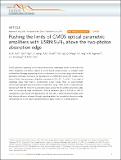| dc.contributor.author | Ooi, K. J. A. | |
| dc.contributor.author | Ng, D. K. T. | |
| dc.contributor.author | Wang, T. | |
| dc.contributor.author | Chee, A. K. L. | |
| dc.contributor.author | Ng, S. K. | |
| dc.contributor.author | Wang, Q. | |
| dc.contributor.author | Ang, L. K. | |
| dc.contributor.author | Tan, D. T. H. | |
| dc.contributor.author | Agarwal, Anuradha | |
| dc.contributor.author | Kimerling, Lionel C | |
| dc.date.accessioned | 2017-06-21T17:54:15Z | |
| dc.date.available | 2017-06-21T17:54:15Z | |
| dc.date.issued | 2017-01 | |
| dc.date.submitted | 2016-08 | |
| dc.identifier.issn | 2041-1723 | |
| dc.identifier.uri | http://hdl.handle.net/1721.1/110129 | |
| dc.description.abstract | CMOS platforms operating at the telecommunications wavelength either reside within the highly dissipative two-photon regime in silicon-based optical devices, or possess small nonlinearities. Bandgap engineering of non-stoichiometric silicon nitride using state-of-the-art fabrication techniques has led to our development of USRN (ultra-silicon-rich nitride) in the form of Si[subscript 7]N[subscript 3], that possesses a high Kerr nonlinearity (2.8 × 10[superscript −13] cm[superscript 2] W[superscript −1]), an order of magnitude larger than that in stoichiometric silicon nitride. Here we experimentally demonstrate high-gain optical parametric amplification using USRN, which is compositionally tailored such that the 1,550 nm wavelength resides above the two-photon absorption edge, while still possessing large nonlinearities. Optical parametric gain of 42.5 dB, as well as cascaded four-wave mixing with gain down to the third idler is observed and attributed to the high photon efficiency achieved through operating above the two-photon absorption edge, representing one of the largest optical parametric gains to date on a CMOS platform. | en_US |
| dc.description.sponsorship | Singapore Ministry of Education. Academic Research Fund (AcRF) Tier 2 grant | en_US |
| dc.description.sponsorship | Singapore. Agency for Science, Technology and Research (PSF grant) | en_US |
| dc.description.sponsorship | SUTD-MIT International Design Centre (IDC) | en_US |
| dc.description.sponsorship | Temasek Laboratories | en_US |
| dc.description.sponsorship | National Research Foundation of Singapore (Medium Sized Centre Program) | en_US |
| dc.language.iso | en_US | |
| dc.publisher | Nature Publishing Group | en_US |
| dc.relation.isversionof | http://dx.doi.org/10.1038/ncomms13878 | en_US |
| dc.rights | Creative Commons Attribution 4.0 International License | en_US |
| dc.rights.uri | http://creativecommons.org/licenses/by/4.0/ | en_US |
| dc.source | Nature | en_US |
| dc.title | Pushing the limits of CMOS optical parametric amplifiers with USRN:Si7N3 above the two-photon absorption edge | en_US |
| dc.type | Article | en_US |
| dc.identifier.citation | Ooi, K. J. A., D. K. T. Ng, T. Wang, A. K. L. Chee, S. K. Ng, Q. Wang, L. K. Ang, A. M. Agarwal, L. C. Kimerling, and D. T. H. Tan. “Pushing the Limits of CMOS Optical Parametric Amplifiers with USRN:Si7N3 Above the Two-Photon Absorption Edge.” Nature Communications 8 (January 4, 2017): 13878. | en_US |
| dc.contributor.department | Massachusetts Institute of Technology. Materials Processing Center | en_US |
| dc.contributor.department | Massachusetts Institute of Technology. Department of Materials Science and Engineering | en_US |
| dc.contributor.department | Massachusetts Institute of Technology. Microphotonics Center | en_US |
| dc.contributor.mitauthor | Agarwal, Anuradha | |
| dc.contributor.mitauthor | Kimerling, Lionel C | |
| dc.relation.journal | Nature Communications | en_US |
| dc.eprint.version | Final published version | en_US |
| dc.type.uri | http://purl.org/eprint/type/JournalArticle | en_US |
| eprint.status | http://purl.org/eprint/status/PeerReviewed | en_US |
| dspace.orderedauthors | Ooi, K. J. A.; Ng, D. K. T.; Wang, T.; Chee, A. K. L.; Ng, S. K.; Wang, Q.; Ang, L. K.; Agarwal, A. M.; Kimerling, L. C.; Tan, D. T. H. | en_US |
| dspace.embargo.terms | N | en_US |
| dc.identifier.orcid | https://orcid.org/0000-0002-3913-6189 | |
| mit.license | PUBLISHER_CC | en_US |
